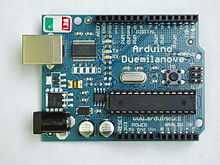Electrical engineering technology

Electrical/Electronics Engineering Technology (EET) is an engineering technology field that implements and applies the principles of electrical engineering.[1] Like electrical engineering, EET deals with the "design, application, installation, manufacturing, operation and/or maintenance of electrical/electronic(s) systems."[2] However, EET is a specialized discipline that has more focus on application, theory, and applied design, and implementation, while electrical engineering may focus more of an generalized emphasis on theory and conceptual design.[3] Electrical/Electronic engineering technology is the largest branch of engineering technology and includes a diverse range of sub-disciplines, such as applied design, electronics, embedded systems, control systems, instrumentation, telecommunications, and power systems.
Education
Accreditation
The Accreditation Board for Engineering and Technology (ABET) is the recognized[4] organization for accrediting both undergraduate engineering and engineering technology programs in the United States.[5]
Coursework
EET curricula can vary widely by institution type, degree type, program objective, and expected student outcome. Each year, however, ABET publishes a set of minimum criteria that a given EET program (either associate degree or bachelor's degree) must meet in order to maintain its ABET accreditation. These criteria may be classified as either general criteria, which apply to all ABET accredited programs, or as program criteria, which apply to discipline-specific criteria.[6]
Associate degree
Associate degree programs emphasize the practical field knowledge that is needed to maintain or troubleshoot existing electrical/electronic systems or to build and test new design prototypes.
Discipline-specific program outcomes include the application of:
- circuit analysis and design
- analog and digital electronics
- computer programming
- associated software
- relevant engineering standards
Coursework must be at a minimum algebra and trigonometry based.[2]
Bachelor's degree
Bachelor’s degree programs emphasize the analysis, design, and implementation of electrical/electronic systems. Some programs may focus on a specific sub-discipline, such as control systems or communications systems, while others may take a broader approach, introducing the student to several different sub-disciplines.[2]
Math to differential equations is a minimum requirement for ABET accredited bachelor’s level EET degrees. In addition, graduates must demonstrate an understanding of basic project management skills.[2]
The United States Department of Commerce classifies the bachelor of science in electrical engineering technology (BSEET) as a STEM undergraduate engineering degree field.[7]
In many states, recent graduates and students who are close to finishing an undergraduate BSEET degree are qualified to sit-in for the Fundamentals of Engineering exam[8] while those BSEETs who have already gained at least four years’ post-college experience are qualified to sit-in for the Professional Engineer exam[9] for their licensure in the United States. The importance of the licensing board requirements[10] depend upon location, level of education, required years of experience, and the BSEETs sub-discipline are the passageways for becoming a licensed engineer. The knowledge obtained by a TAC/ABET accredited program is one pathway that may help students prepare for and pass the FE/PE exam. For example, in the United States and Canada, "only a licensed engineer may seal engineering work for public and private clients".[11]
Career
Graduates of electrical/electronics engineering technology programs work in a wide range of career fields. Some examples include:
- Engineering management
- Telecommunications
- Signal processing
- Medical technology and devices
- Instrumentation
- Integration Engineer
- Control
- Aerospace and avionics
- Computers
- Electrical power industry and power distribution
- Optics and Optoelectronics
- Manufacturing and manufacturing test engineer
- Marine Engineering
- Research and development
- Project management and Operations research
Associate degree
Electrical/electronic engineering technicians may have a two-year associate’s degree [12] and considered craftsman technicians. Eventually, with additional experience and certifications obtained then the craftsman technicians may advance to master craftsman technicians.
Bachelor degree
Electrical/electronic engineering technologists are broad specialists, rather than central technicians. EETs have a bachelor degree and are considered applied electrical or electronic engineers because they have electrical engineering concepts to use in their work.[12]Entry-level jobs in electrical or electronics engineering generally require a bachelor's degree in electrical engineering, electronics engineering, or electrical engineering technology. [13]
See also
- Outline of engineering
- IEEE
- Applied science
- Mechanical engineering technology
- Computer engineering
- Manufacturing engineering
References
- ↑ "Electrical Engineering Technology". Engineering Technology Overview. Sloan Career Cornerstone Center. Retrieved 20 August 2010.
- ↑ 2.0 2.1 2.2 2.3 "Criteria for Accrediting Engineering Technology Programs, 2012 - 2013". Program Criteria. ABET. pp. 13–14. Retrieved 20 May 2012.
- ↑ "Engineering vs. Engineering Technology". Curricular Focus. ABET. Retrieved 20 May 2012.
- ↑ "Programmatic Accrediting Organizations". Directory of CHEA-Recognized Organizations. Council for Higher Education Accreditation. Retrieved 22 September 2010.
- ↑ "What is ABET?". General Information (ABET). VaNTH ERC. Retrieved 22 September 2010.
- ↑ "Criteria for Accrediting Engineering Technology Programs, 2012 - 2013". Criteria for Accrediting Engineering Technology Programs. ABET. p. 1. Retrieved 20 May 2012.
- ↑ Langdon et al. "Criteria for Accrediting Engineering Technology Programs, 2012 - 2013". STEM: Good Jobs Now and for the Future. U.S. Department of Commerce. p. 2,9. Retrieved 20 May 2012.
- ↑ "FE Requirements". NCEES. Retrieved 28 November 2014.
- ↑ "PE Requirements". NCEES. Retrieved 28 November 2014.
- ↑ "Exam Requirements". NCEES. Retrieved 20 May 2012.
- ↑ "Why Should You Get Licensed?". National Society of Professional Engineers. Archived from the original on June 4, 2005. Retrieved 11 July 2005.
- ↑ 12.0 12.1 "Electrical and Electronic Engineering Technicians". Occupational Outlook Handbook, 2012-13 Edition. Bureau of Labor Statistics, U.S. Department of Labor. Retrieved August 18, 2012.
- ↑ "Electrical and Electronic Engineer". Occupational Outlook Handbook, 2012-13 Edition. Bureau of Labor Statistics, U.S. Department of Labor. Retrieved November 15, 2014.
External links
- IEEE Global History Network A wiki-based site with many resources about the history of IEEE, its members, their professions and electrical and informational technologies and sciences.
| ||||||||||||||||||||||||||||||